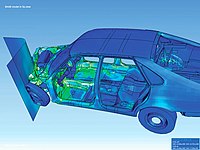
Photo from wikipedia
Abstract Surface nanostructuration of metallic components has attracted significant interest since the end of the 1980s, owing to its ability to increase the material hardness, yield stress, fatigue life, and… Click to show full abstract
Abstract Surface nanostructuration of metallic components has attracted significant interest since the end of the 1980s, owing to its ability to increase the material hardness, yield stress, fatigue life, and corrosion resistance. Ultrasonic shot peening is one of the commonly used surface nanostructuration methods, which is derived from the conventional shot peening process. It induces multi-directional impacts with a relatively low bead speed, which enhance the surface integrity and facilitate the microstructural changes caused by the surface treatment. Thus, the development of a reliable model of multi-impacts on a microscopic scale would allow more accurate prediction of the resulting microstructural modifications. The currently used finite element models utilize the crystal plasticity laws based on the dislocation dynamics to analyze possible microstructural surface changes (including crystal rotations and variations of the dislocation density) under multiple normal and oblique impacts. First, the evolution of a local misorientation field under a single normal impact, quantified by the kernel average misorientation, was studied both experimentally and theoretically. After that, the proposed crystal plasticity formulation was used to quantify the effect of the material microstructure on the residual compressive stress induced by multiple impacts. As expected, the value of the maximum compressive stress was not changed after few impacts. In addition, particular attention was paid to the evolution of the dislocation density and disorientations inside the grains. The obtained results indicate that in contrast to the normal impacts, the oblique impacts did not significantly modify the compressive residual stress, but strongly affected the metal microstructure near the surface in terms of its disorientation and dislocation density.
Journal Title: International Journal of Plasticity
Year Published: 2018
Link to full text (if available)
Share on Social Media: Sign Up to like & get
recommendations!